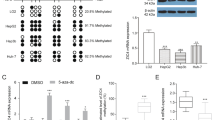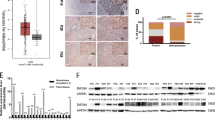Abstract
Purpose
Hepatocellular cancer (HCC) is a deadly and most rapidly increasing cancer in the USA and worldwide. The etiology and factors involved in development of HCC remain largely unknown. A marked decrease in zinc occurs in HCC. Its role and involvement in HCC has not been identified. We investigated the relationship of cellular zinc changes to the development of malignancy, and the identification of potential zinc transporters associated with the inability of hepatoma cells to accumulate zinc.
Methods
The detection of relative zinc levels in situ in normal hepatic cells vs. hepatoma was performed on normal and HCC tissue sections. ZIP1, 2, 3, and 14 transporters were identified by immunohistochemistry.
Results
Intracellular zinc levels are markedly decreased in HCC hepatoma cells vs. normal hepatic cells in early stage and advanced stage malignancy. ZIP14 transporter is localized at the plasma membrane in normal hepatocytes, demonstrating its functioning for uptake and accumulation of zinc. The transporter is absent in the hepatoma cells and its gene expression is downregulated. The change in ZIP14 is concurrent with the decrease in zinc. ZIP1, 2, 3 are not associated with normal hepatocyte uptake of zinc, and HCC zinc depletion. HepG2 cells exhibit ZIP14 transporter. Zinc treatment inhibits their growth.
Conclusions
ZIP14 downregulation is likely involved in the depletion of zinc in the hepatoma cells in HCC. These events occur early in the development of malignancy possibly to protect the malignant cells from tumor suppressor effects of zinc. This provides new insight into important factors associated with HCC carcinogenesis.








Similar content being viewed by others
References
Jemal A, Siegel R, Xu J, Ward E. Cancer statistics, 2010. CA Cancer J Clin. 2010;60:277–300.
Danielsen A, Steinnes E. A study of some selected trace elements in normal and cancerous tissue by neutron activation analysis. J Nucl Med. 1970;11:260–4.
Ebara M, Fukuda H, Hatano R, Saisho H, Nagato Y, et al. Relationship between copper, zinc and metallothionein in hepatocellular carcinoma and its surrounding liver parenchyma. J Hepatol. 2000;33:415–22.
Liaw KY, Lee PH, Wu FC, Tsai JS, Lin-Shiau SY. Zinc, copper, and superoxide dismutase in hepatocellular carcinoma. Am J Gastroenterol. 1997;92:2260–3.
Tashiro H, Kawamoto T, Okubo T, Koide O. Variation in the distribution of trace elements in hepatoma. Biol Trace Elem Res. 2003;95:49–63.
Tashiro-Itoh T, Ichida T, Matsuda Y, Satoh T, Sugiyama M, et al. Metallothionein expression and concentrations of copper and zinc are associated with tumor differentiation in hepatocellular carcinoma. Liver. 1997;17:300–6.
Gurusamy K, Davidson BR. Trace element concentration in metastatic liver disease: a systematic review. J Trace Elem Med Biol. 2007;21:169–77.
Al-Ebraheem A, Farquharson MJ, Ryan E. The evaluation of biologically important trace metals in liver, kidney and breast tissue. Appl Radiat Isot. 2009;67:470–4.
Sternberg CA, Philips FS. Histochemical demonstration of zinc in the dorsolaterl prostate of the rat:studies with oxine and dithizone. Am J Pathol. 1965;47:325–37.
Franklin RB, Feng P, Milon BC, Desouki MM, Singh KK, et al. hZIP1 zinc uptake transporter down regulation and zinc depletion in prostate cancer. Mol Cancer. 2005. doi:10.1186/1476-4598-4-32.
Johnson LA, Kanak MA, Kajdacsy-Balla A, Pestaner JP, Bagasra O. Differential zinc accumulation and expression of human zinc transporter 1 (hZIP1) in prostate glands. Methods. 2010;52:316–21.
Desouki MM, Geradts J, Milon B, Franklin RB, Costello LC, et al. hZip2 and hZip3 zinc transporters are down regulated in human prostate adenocarcinomatous glands. Mol Cancer. 2007. doi:10.1186/1476-4598-6-37.
Lipman TO, Diamond A, Mellow MH, Patterson KY. Esophageal zinc content in human squamous esophageal cancer. J Am Coll Nutr:. 1987;6:41–6.
Taylor KM, Morgan HE, Johnson A, et al. Structure-function analysis of a novel member of the LIV-1 subfamily of zinc transporters, ZIP14. FEBS Lett. 2005;579:427–32.
Lichten LA, Cousins RJ. Interleukin-1beta contributes via nitric oxide to the upregulation and functional activity of the zinc transporter Zip14 (Slc39a14) in murine hepatocytes. Ann Rev Nutr. 2009;29:153–76.
Liuzzi JP, Cousins RJ. Interleukin-6 regulates the zinc transporter Zip14 in liver and contributes to the hypozincemia of the acute-phase response. Ann Rev Nutr. 2004;24:151–72.
Franklin RB, Costello LC. Zinc as an anti-tumor agent in prostate cancer and in other cancers. Arch Biochem Biophys. 2007;463:211–7.
Costello LC, Franklin RB. The clinical relevance of the metabolism of prostate cancer; zinc and tumor suppression: connecting the dots. Mol Cancer. 2006. doi:10.1186/1476-4598-5-17.
Lemire J, Mailloux R, Appanna VD. Zinc toxicity alters mitochondrial metabolism and leads to decreased ATP production in hepatocytes. J Appl Toxicol. 2008;28:175–82.
Ohashi T, Matsui T, Chujo M, Nagao M. Restraint stress up-regulates expression of zinc transporter Zip14 mRNA in mouse liver. Cytotech. 2008;57:181–5.
Weaver BP, Zhang Y, Hiscox S, Guo GL, Apte U, et al. Zip4 (Slc39a4) expression is activated in hepatocellular carcinomas and functions to repress apoptosis, enhance cell cycle and increase migration. PLoS One. 2010. doi:10.1371/journal.pone.0013158.
Costello LC, Franklin RB. Metabolic transformations of malignant cells: an overview. In: Hyatt MA, editor. Methods of cancer diagnosis, therapy, and prognosis, vol 2 general methods and overviews, lung carcinoma and prostate carcinoma. New York: Springer; 2008. p. 3–16.
Costello LC, Franklin RB. Integration of genetic, proteomic, and metabolic approaches in tumor cell metabolism. In: Singh KK, Costello LC, editors. Mitochondria and Cancer. New York: Springer; 2009. p. 79–92.
Anthony PP, Cl V, Barker LF. Liver cell dysplasia: a premalignant condition. J Clin Pathol. 1973;26:217–23.
Koo JS, Kim H, Park BK, Ahn SH, Han KH, et al. Predictive value of liver cell dysplasia for development of hepatocellular carcinoma in patients with chronic hepatitis B. J Clin Gastroenterol. 2008;42:738–43.
Le Bail B, Bernard PH, Carles J, Ahn SH, Han KH, et al. Prevalence of liver cell dysplasia and association with HCC in a series of 100 cirrhotic liver explants. J Hepatol. 1997;27:835–42.
Podda M, Roncalli M, Battezzati PM, Borzio M, Bruno S, et al. Liver-cell dysplasia and hepatocellular carcinoma. Ital J Gastroenterol. 1992;24:39–42.
Acknowledgements
We are grateful to Dr. Robert Cousins (University of Florida) for kindly providing us with the ZIP14 antibody employed in this study. We are also grateful to Dr. Peter Zalewski (University of Adelaide, Australia) for kindly providing us with the Zinquin ester employed in this study. These studies were supported by NIH grants DK076783 and CA79903.
Author information
Authors and Affiliations
Corresponding authors
Rights and permissions
About this article
Cite this article
Franklin, R.B., Levy, B.A., Zou, J. et al. ZIP14 Zinc Transporter Downregulation and Zinc Depletion in the Development and Progression of Hepatocellular Cancer. J Gastrointest Canc 43, 249–257 (2012). https://doi.org/10.1007/s12029-011-9269-x
Published:
Issue Date:
DOI: https://doi.org/10.1007/s12029-011-9269-x




